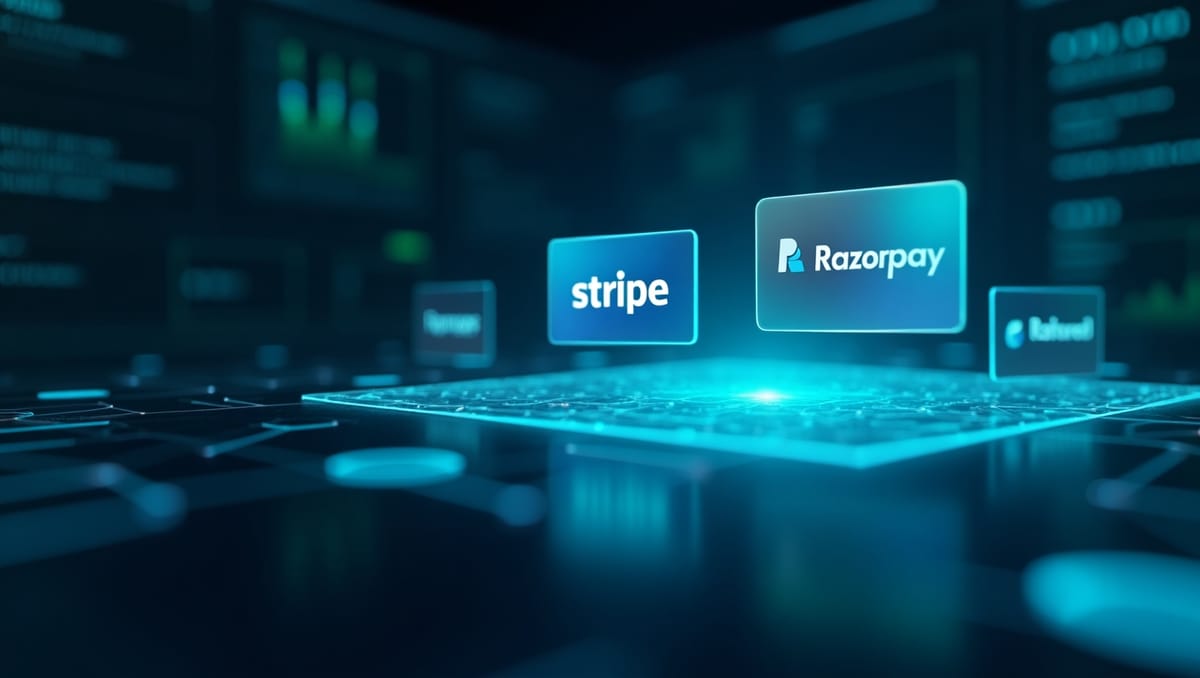What Developers Need to Know About Payment Gateways in 2025
Choosing a payment gateway in 2025 can be overwhelming. In this guide, I share practical advice from a developer’s point of view — including real examples, code, and a side-by-side comparison of Stripe, Razorpay, PayPal, and more.

Managing payments is one of the most common yet nerve-wracking tasks developers face. With so many gateways to choose from—Stripe, Razorpay, PayPal, Paystack, Flutterwave—deciding which one fits your project can feel overwhelming.
In this blog, I’ll walk you through:
- What makes a gateway developer-friendly
- Real-world comparison of popular options
- Integration considerations and code snippets
- Tips to surface real data with tools like BuiltWith or SimilarWeb
Let’s cut through the noise and make choosing a payment gateway practical and stress-free.
🧠 TLDR
- Choosing a payment gateway in 2025 depends on where your users are, what you’re building, and how much control you want.
- Stripe is great for global apps with polished developer tools.
- Razorpay is ideal for Indian startups with strong local support.
- Consider fees, currency support, API quality, and payout timing before you decide.
- I’ve shared real-world examples, code snippets, and tools to help you choose the right one confidently.
🧭 Why Choosing the Right Payment Gateway Matters
I remember when I first integrated Stripe into my e‑commerce mini‑app. Everything was smooth until I realized international payment support, FX rates, and onboarding fees varied drastically from what I'd read in docs. I’d wished I had evaluated those details earlier.
You should consider:
- Supported countries and currencies
- Developer experience and docs
- Fees per transaction
- Onboarding & KYC process
- Security & compliance (PCI DSS)
Trust me, what looks like a few extra cents per transaction can add up fast.
🔍 Popular Gateways (2025–24 Comparison)
Here’s a quick side-by-side of what I’ve seen used most in real apps:
| Gateway | Supported Regions | Transaction Fee (in 2025) | Dev Experience | Payout Frequency |
|---|---|---|---|---|
| Stripe | Global (40+ countries) | ~2.9% + $0.30 | Excellent | 2-day or daily |
| Razorpay | India | ~2% + ₹3 | Great for India | T+2 days |
| PayPal | Global | 2.9% + $0.30 | Easy but heavy | Daily or weekly |
| Paystack | Africa | 1.5% flat or 3.9% | Clean API | 2-day auto |
| Flutterwave | Africa & international | 3.8% + ₦50 | Keep an eye on UI | T+2 days |
🌐 Using Tools to Track Real Usage
To know what’s trending, I recommend checking out:
- BuiltWith: shows which gateways power popular sites
- SimilarWeb: measures traffic and usage of gateway pages
- Google Trends: monitors interest over time
⚙️ Developer Experience and Integration
✅ Stripe Example (Node.js)
// Install: npm install stripe
import Stripe from 'stripe';
const stripe = new Stripe(process.env.STRIPE_SECRET);
app.post('/api/create-payment', async (req, res) => {
const { amount, currency } = req.body;
const paymentIntent = await stripe.paymentIntents.create({
amount,
currency,
payment_method_types: ['card'], });
res.json({ clientSecret: paymentIntent.client_secret });
}); That straightforward, consistent API is one of Stripe’s biggest wins in my experience.
✅ Razorpay Example (Node.js)
// Install: npm install razorpay
import Razorpay from 'razorpay';
const razorpay = new Razorpay({
key_id: process.env.RAZORPAY_KEY,
key_secret: process.env.RAZORPAY_SECRET,
});
app.post('/api/create-order', async (req, res) => {
const order = await razorpay.orders.create({
amount: 5000, // ₹50.00
currency: 'INR',
receipt: 'receipt#1',
}); res.json(order);
}); Razorpay’s flow is clear, though handling webhooks and naming is a bit more verbose than Stripe.
👨💻 Developer Checklist
Here’s what I evaluate before choosing a gateway:
- SDK and Security: Ensure you can securely handle tokens or sessions
- Testing Sandbox: Does it offer a test environment? Yes
- Webhooks or Callbacks: Easy to verify real payment events
- Network Reliability: Retry logic for failed callbacks
- Reporting: Easy to reconcile payouts and expenses
💡 Onboarding and Compliance
- Stripe and PayPal are fast onboarding with KYC.
- Razorpay requires documentation for Indian businesses.
- Paystack & Flutterwave have region-specific flows.
Always expect ~1–2 days for account review and confirmations.
✅ Final Thoughts
If you’re building a global SaaS or shop → start with Stripe.
If you're focused in India → Razorpay is excellent.
If you're shipping to Africa/America → consider Paystack or Flutterwave.
Whichever you choose, integrate wisely:
- Track costs
- Monitor locales/currencies
- Enable retries & logging
A bad payment experience in production can ruin a lead.
Better to get it right once — and focus on the product.
🔗 Related Reads
💬 Connect With Me
I’d love to hear your payment gateway experiences. Drop a comment or connect with me on Twitter or LinkedIn.




